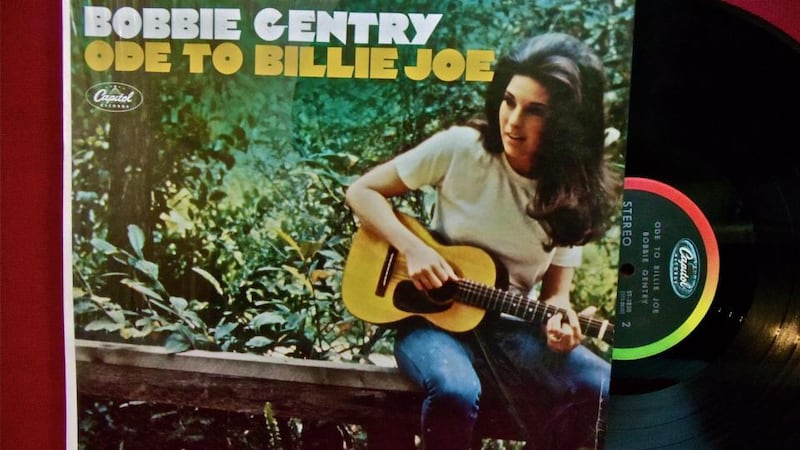It was July 1967.
When the needle dropped you would have heard the insistent strum of what sounded like a small guitar in a big room, and then the woozy swoop of a string section as it slid down along a minor scale. Then Bobbie Gentry’s cool vocals came in and, in a little over four minutes, told a deeply gothic Southern tale about a mystery that you couldn’t quite solve, suffused by a darkness she refused to illuminate.
Who was Billie Joe McAllister and why did he die? In Gentry’s song Ode to Billie Joe, a hit single that knocked the Beatles’ All You Need Is Love from the top of the US charts, McAllister is reported, by the narrator’s mother, to have jumped from the Tallahatchee Bridge. Stranger still: before his death, what were Billie Joe and the “girl that looked a lot like” the narrator throwing from the bridge?

I say “narrator” because Ode to Billie Joe feels more like a short story: it creates and sustains a certain uneasy atmosphere. Aside from the question of what may have happened, the lyrics also portray the context: the narrator’s family’s emotional distance, impassive and unmoved by Billie Joe’s death. Her father says: ‘”Well, Billie Joe never had a lick o’ sense, pass the biscuits please”. This matter-of-fact repression lends the song much of its edginess.
There's another riddle to be solved: that of Gentry herself, in 1967 a dark-haired 22-year-old originally from Mississippi, who became a huge star on the strength of the Billie Joe song, recorded an album with Glen Campbell, became friends with Elvis, apparently dabbled in the repugnant "objectivist" philosophy of novelist Ayn Rand, played big shows in Las Vegas and Tahoe casinos, and then, by the early 1980s, disappeared completely from public view.
The American journalist Tara Murtha, in her recently published book Ode to Billie Joe (Bloomsbury), attempts to solve these mysteries. Her book, then, is a reporter’s quest that takes her across America to find people who knew Gentry and are willing to talk.
She finds plenty of them, from Jimmie Haskell, who arranged the strings on Ode to Billie Joe and Gentry's album of the same name, to the star's step-brother Bryan Holley, whom the author visits in his house in Oregon.
Holley inherited boxes of Gentry’s discarded possessions from his father, and insists that he’s keen to return them to her – but he’s only met her once. He encourages Murtha to try on Gentry’s fur coat, then allows the journalist to leave with a box of the star’s possessions. Murtha acknowledges her invasiveness: “sometimes the line between being a journalist and plain old creepy is thin as skin”.
It's not that there aren't precedents for writing about subjects who won't talk. Gay Talese's Frank Sinatra Has A Cold, published by Esquire magazine in 1966, being perhaps the most famous example. Sinatra refused to talk to Talese, so instead the journalist observed him and talked to numerous people surrounding the star. Biographers do it all the time when writing about the dead.
Nevertheless, there’s something undeniably intriguing about an artist who’s still alive but refuses interviews. They soon acquire a reputation as reclusive – JD Salinger and Harper Lee come to mind. Their silence elevates them to a near-mythical status, and thus makes them all the more attractive to the journalist on a quest.
Murtha states early on in the book that she wrote to Gentry, who, through an intermediary, refused to grant her an interview. She justifies sorting through Gentry’s possessions at Bryan Holley’s house in this way: “Gentry is entitled to privacy, but the collateral damage is an erasure of her pioneering accomplishments.”
Certainly there are those who claim to have co-written Ode to Billie Joe, primarily the songwriter Jim Ford. Investigating these claims, Murtha talks to singer-songwriter PJ Proby, who says that Ford didn't write it: "he tried to steal it from Bobbie Gentry and tried to make her put his name on it".
But back to the song's central mystery. What did they throw from the Tallahatchee Bridge? David Axelrod, a staff producer at Capitol Records when Gentry signed with the company, tells Murtha that the song "is about abortion".
Perhaps. But the whole point of the song, it seems, is to encourage this kind of speculation – the listener’s search for the definitive explanation. Maybe Gentry herself could shed some light on it? But surely she won’t talk, not now.
Murtha interviews Frank Llacuna, a guitar player in a Hawaiian-themed troupe of which Gentry was a member just before her breakthrough. He talks about hearing Gentry play the song to him, and how she intended it to puzzle and tease: "she had the vision that the people would talk about it, wonder what they threw over the bridge".
To Gentry, speaking to the Los Angeles Times in August 1967, what was thrown from the bridge didn’t actually matter: “You have to establish some motivation. What happened the day before on the bridge was the motivation, but I left it open so the listener could draw his own conclusion.”
The mystery of Gentry’s song is one that can never be fully resolved, hence its endurance; her silence, if anything, amplifies that mystery.
Karl Whitney is the author of Hidden City: Adventures and Explorations in Dublin (Penguin)










